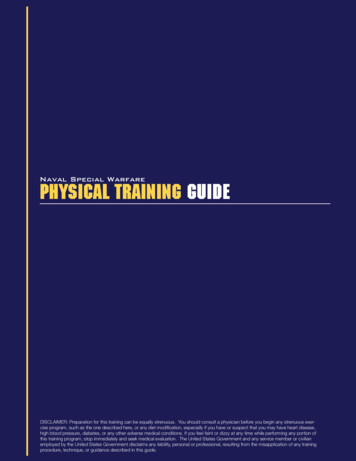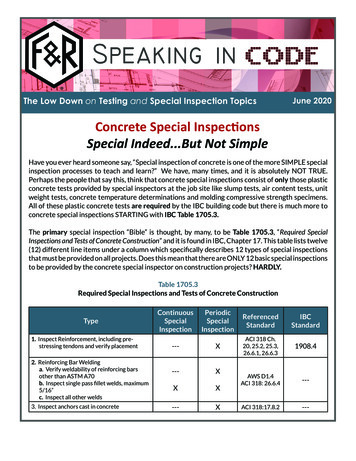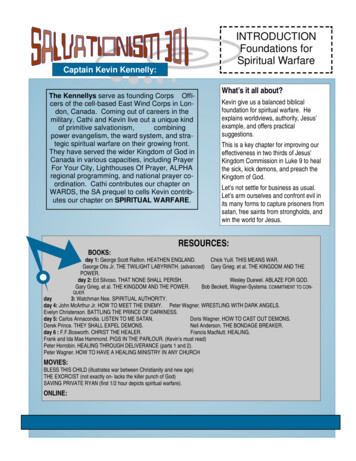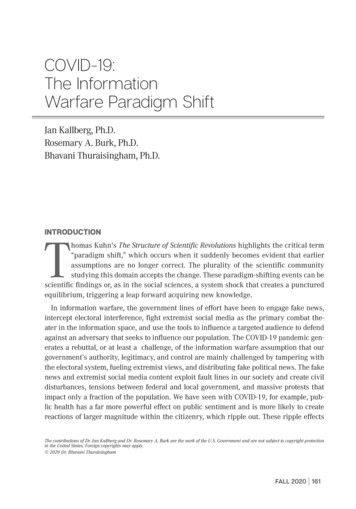
Transcription
Naval Special WarfarePhysical Training GuideDISCLAIMER: Preparation for this training can be equally strenuous. You should consult a physician before you begin any strenuous exercise program, such as the one described here, or any diet modification, especially if you have or suspect that you may have heart disease,high blood pressure, diabetes, or any other adverse medical conditions. If you feel faint or dizzy at any time while performing any portion ofthis training program, stop immediately and seek medical evaluation. The United States Government and any service member or civilianemployed by the United States Government disclaims any liability, personal or professional, resulting from the misapplication of any trainingprocedure, technique, or guidance described in this guide.
The Naval Special WarfarePhysical Training Guideis designed to assist anyonewho wants to improve his fitness in order to take and passthe Physical Screening Test(PST) and succeed at BasicUnderwater Demolition/SEAL(BUD/S).This guide provides information about the type of training required to properly prepare for the rigors of BUD/S,and it offers a tailorable 26week training plan that shouldhelp a person with averagefitness prepare for trainingand avoid injury.Most of your cardiovascular exercise shouldGeneral Training Guidelinesfocus on running andswimming, and yourYour workouts should bestrength and calisthenics Planned and organizedtraining should be done Gradual, steady and continualto develop the necessary Consistentmuscular strength and Specificendurance for maximum Balancedpull-ups, push-ups andWeeklyWorkoutSummary 1 Long Slow Distance workout for both running and swimming1 Continuous High Intensity workout for both running and swimming1 Interval workout for both running and swimming4-5 Calisthenics Routines4-6 Strength Training Sessions – 2-3 each for upper and lower body4-5 Core Exercise RoutinesDaily Flexibility RoutinesSpecific injury prevention exercises as neededLong Slow Distance (LSD)Workoutssit-ups as they are necessaryfor success at BUD/S. Crosstraining such as cycling,rowing and hiking is useful torehabilitate an injury, to addvariety or to supplement yourbasic training.Work to improve yourweakest areas. If you are asolid runner but a weak swimmer, don’t spend all your timerunning just because you aregood at it. Move out of yourcomfort zone, and spendenough time in the water tobecome a solid swimmer aswell.The intensity of LSD work is low to moderate, so your pace should feel relatively easyand relaxed. These workouts build enduranceand provide relative recovery between moreintense sessions. To determine the appropriate intensity, use the Talk Test. You should beable to talk comfortably in short sentences orphrases while training, drawing breath beContinuous High Intensity (CHI)These sessions typically involve movingfor 15-20 minutes without stopping at a paceapproximately 90-95% of the maximal pacetween phrases. If you can’t speak, you areworking too hard, and if you can speak continually, you are not working hard enough. ForLSD workouts, focus more on duration thanintensity. If you are exceptionally fit, you mightperform 40-90 minutes of continuous movement in one session. A practical goal to prepare for BUD/S is to build up to comfortablyrunning 5-6 miles or swimming 1-1.25 mileswithout stopping.you could hold for that duration. The workout should be very demanding but not totallyexhausting. On a scale of 1-10, with 10 being the greatest effort possible, the workoutPhysical Training Guide Page 2www.sealswcc.com
should feel like 8-9. If you are at a low fitnesslevel, one repetition of 15-20 minutes is sufficient. As your fitness improves, 2-3 repetitions may be required. When performing morethan one repetition, allow sufficient recoverybetween repetitions so you can maintain theInterval (INT)These sessions alternate short, intensework intervals with periods of recovery. Theformat consists of running 1/4-mile intervalsor swimming 100-yard intervals, allowing arecovery period of 2-2 1/2 times the amountof time it takes to perform the work interval.Your intensity or pace should be slightly faster than the pace of your most recent 1.5-milerun or 500-yard swim. For running, your 1/4mile interval pace should initially be about4 seconds faster than your base pace, andfor swimming, your 100-yard interval paceshould initially be 2 seconds faster than yourbase. For example, if you recently completeddesired intensity of 90-95% of maximal pace.A reasonable recovery period is approximately half of the work time. During this time,keep moving at a low intensity – slow jog,brisk walk or easy stroke. Do not come to acomplete stop.a 1.5-mile run in 10:30 – 1/4 mile base paceof 1:45 – your interval training pace shouldbe about 1:41. If you completed a 500-yardswim in 10:30 – 100-yard base pace of 2:06 –intervals should be approximately 2:04.Begin your interval workouts with 4 intervls per session, and build progressivelytoward completing 10 intervals. Do not runor swim more than 10 intervals during aninterval session. When you can complete10 intervals in the prescribed times, workon gradually performing the intervals a littlefaster each week. Work on consistency,trying to keep little variation between yourfastest and slowest interval and pacingRunIf your currentpace isSwimThen your workout isIf your currentpace isThen your workout is100-yard repeat timerecovery time1/4-mile repeat timerecovery 3:04-3-106:08-7:55Table 1 Interval PacesTable 1 provides appropriate paces and recovery times for interval workouts.Physical Training Guide Page 3www.sealswcc.com
yourself to be fastest at the end of the workout. Every 4th or 5th week, it may be beneficial to increase your intensity using shorter,more frequent intervals. For example, 16-20 x220-yard running intervals or 16-20 x 50-yardswimming intervals.CalisthenicsDuring BUD/S and for the PST, you willbe required to perform numerous push-ups,sit-ups and pull-ups. You should preparespecifically for these exercises. Using propertechnique, perform sets of push-ups, sit-upsand pull-ups 4-5 times per week, resting 1-2minutes between sets. Though the PST requires the exercises to be performed as rapidlyas possible, you should perform most of yourtraining exercises in a slow and controlledmanner. The negative or downward portionshould take at least twice as long as the positive or upward portion. Approximately once perweek, perform a max set (maximal number ofconsecutive repetitions) to assess your progress.Here are descriptions of each exercise asthey must be performed during the PST. Whiletraining, you may occasionally do alternateversions for variety and additional fitness adaptations.Push-up Begin in the up or front-leaning rest position, with feet together and palms on floordirectly beneath or slightly wider thanshoulders. Back, buttocks and legs should remainstraight from head to heels at all times.Palms and toes remain in contact with thefloor. Lower the entire body as a single unit bybending the elbows until the arms formright angles, then return to the startingposition by extending the elbows, raisingthe body as a single unit until the arms arestraight.Allow enough recovery time to maintain theproper work intensity, without taking excessivetime or wasting time. To promote faster, morecomplete recovery, use some active recovery,such as brisk walking, easy stroking or slow jogging for part of the time between intervals.Variations Use caution with any push-upvariation, since placing the hands in any position other than beneath the shoulders maycreate painful stress on the elbows. Include wide, narrow (triceps) and divebomber Lift one foot off the floor Place feet on a raised surface slightlyhigher than the handsSit-up Begin by lying flat on floor with knees bentand heels approximately 10 inches frombuttocks. Arms should be folded across the chestwith hands touching the upper chest orshoulders. The feet may be stabilized ifdesired. Curl the body up, touching the elbowsto the thighs just below the knees, keeping the hands in contact with the chest orshoulders. After touching elbows to thighs, lie back tillthe shoulder blades touch the floor.Variations With fingers placed loosely behind neck(don’t pull on neck), curl the trunk up androtate so the right elbow contacts the leftknee; lower trunk to floor and bring leftelbow up to right knee; continue alternatingrotations from right to left. Keeping shoulders on the floor and kneesbent, alternate drawing each knee up tothe opposite elbow. Return each leg so thefoot rests on the floor while the other kneeis drawn up. With arms across chest or fingers behindneck, keeping the knees bent, lift the legsPhysical Training Guide Page 4www.sealswcc.com
and hips off the floor drawing the knees towards the shoulders. After the abdominalshave been fully contracted, lower the hipsand legs until the feet touch the floor.above the top of the bar.Legs may be crossed or uncrossed asdesired, but no kipping or jerking motionsallowed.Lower the body in a controlled fashion untilarms and shoulders are fully extended.VariationsNarrow or wide gripSupinated grip with palms toward the bodyto more completely isolate the bicepsHang from bar with hands adjacent andon opposite sides of the bar, palms facinginward in opposite directions, and alternately pull the right and left shoulders up tothe bar (also called the mountain climber orcommando pull-up) Note: for all abdominal exercises, keep thepelvis neutral and the lower back pressed tothe floor to avoid putting stress on the lumbarspine.Pull-up Begin suspended from the bar in a deadhang with arms and shoulders fully extended, palms shoulder width apart andpronated (overhand grip, facing away). Pull body up until chin is even with or Push-ups & Sit-upsPull-upsIf yourmax isSetsThen your workout isRepsTotalIf yourmax isSetsThen your workout isRepsTotal 405-610-1550-90 13-153-48-1024-40 1003-440-50120-200 153-410-1230-48Table 2 Push-up, Sit-up, Pull-up ProgressionTable 2 provides specific training recommendations to improve your maximum number of pushups, sit-ups and pull-ups.Strength Training/Weight Liftingset to provide additional training stimulus, butMuscular strength is necessary to enhance in most cases one set is sufficient to produceperformance on the PST and increase the like- significant increases in strength. Perform asingle set using a weight that cannot be liftedlihood of success at BUD/S. It is important tomore than 8-12 times giving maximal effortgain strength properly to avoid injury.and using proper technique. Generally performThere are many different training protocolsfor building strength and numerous methods of 8-12 exercises per session.Move from one exercise to the next quickly,providing adequate resistance, including freeonly resting the amount of time it takes to setweights, machines and body weight. For theup the proper weight at the next station. Thispurposes of this training, generally perform asingle set of 8-12 repetitions (occasionally 4-6 promotes overall intensity and some cardiorespiratory adaptations. Use a split routinereps or 15-20 reps) of various exercises thatof upper body and lower body exercises ontarget major muscle groups.alternate days.You can occasionally perform a secondPhysical Training Guide Page 5www.sealswcc.com
To the right is a list of exercises you mightincorporate into your strength program. Thislist is not definitive, and individuals may create personalized routines based on equipmentavailability and individual preferences. Alternate a variety of exercises that involve pushing(extension) with pulling (flexion) and target several major muscle groups. Avoid exercises thatrequire high levels of skill unless you are underthe supervision of a qualified coach.Upper Body ExercisesLat pull-downs, shoulder (military) press, biceps curl, bench press or incline press, seatedrow pull, deltoid lateral raise (raise arms parallel to the ground but no higher), upright row,triceps extension or dips.Lower Body ExercisesLunges, leg curl, back hyperextension, deadlifts, leg press or squats, and heel raises.Core ExercisesIt is important to develop the strength andendurance of core muscles in the abdominaland spinal regions. This will improve overallbody balance and alignment, improve stabilityand reduce injury. Sit-ups and push-ups, whichshould be performed regularly in preparationfor BUD/S, are important core exercises. Additional core exercises include the bridge, plank,and bird dog.Bridge Lie on back with knees bent and feet about teninches from buttocks. Keep arms at sides or folded across the chestand keep the pelvis neutral. Raise the hips off the floor, creating a straightline between the knees, hips and shoulders. Lift the right foot off the floor and extend theleg until it is straight and creates a line from theshoulder through the hip, knee and foot. Meanwhile, support the
Underwater Demolition/SEAL (BUD/S). This guide provides infor-mation about the type of train-ing required to properly pre-pare for the rigors of BUD/S, and it offers a tailorable 26-week training plan that should help a person with average fitness prepare for training and avoid injury. Most of your cardio-vascular exercise shouldFile Size: 524KBPage Count: 11











